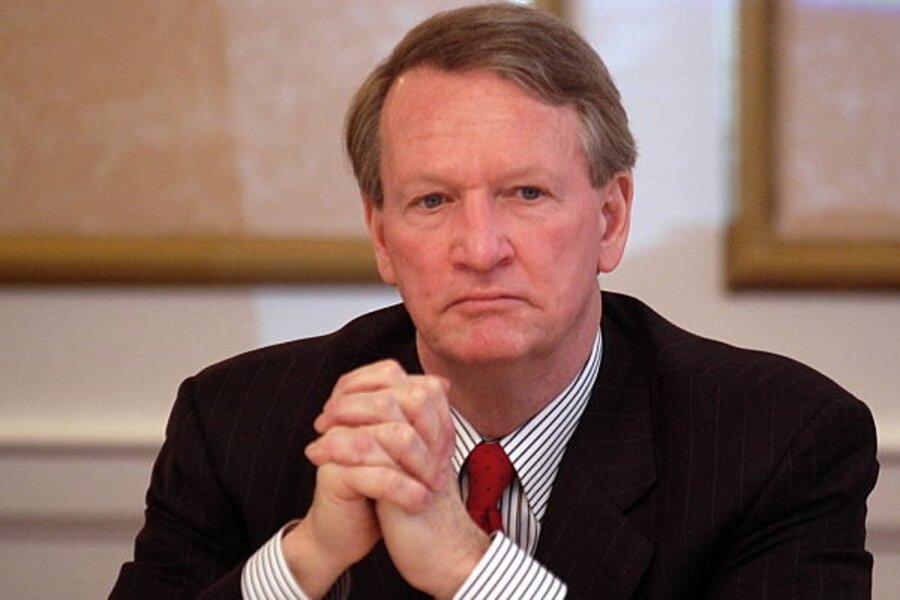Detroit plots green future as its bailout plan
Loading...
| Washington
Emergency federal loans to the US auto industry are just the beginning of an emerging partnership between Detroit carmakers and the US government – a partnership that could shape the industry’s future.
Specifically, in seeking financial help General Motors and Chrysler have outlined a vision of greener product lineups that Washington policymakers also support.
Close ties between Detroit and Washington aren’t new. The car industry has long been influenced heavily by rules of the road set in Washington, such as fuel economy standards. But what’s taking shape now, in the midst of an industry crisis, appears to be a new teamwork that is driven by necessity.
The companies are committing more than ever to shift toward new fuel sources. But to do so at a time when vehicles sales have plunged, they say, will depend on policies such as incentives for consumers to buy cleaner, but costlier, cars.
Consider that sales of hybrid vehicles have plunged in recent months, even as the carmakers are being nudged toward a carbon-conserving future.
The message: Consumers may be interested in helping the environment, but with rising unemployment and gasoline at $2 a gallon, they won’t pay too much for it.
“It’s kind of hard to push [environmental technologies] on people beyond a certain point,” Rick Wagoner, chief executive of General Motors Corp., told reporters at a Monitor-sponsored breakfast Tuesday. Ramping up clean-car sales has “got to be a cooperation between governments and consumers and the industry.”
In reports to the Obama administration in February, GM and Chrysler have already outlined plans to shift their car lineups increasingly toward fuel-efficient models and new technologies such as advanced electric batteries or fuel cells.
Those plans – in addition to cost cutting – are central to the carmakers’ vision of business viability. Billions of dollars in new federal aid hangs on them.
Obama task force in overdrive
In recent weeks, meanwhile, the Obama administration has ramped up its partnership with the industry, by creating a task force to handle the emergency aid.
Task force members were in Detroit recently to test-drive cars such as GM’s electric powered Chevrolet Volt. They learned about fuel cell cars and visited what Mr. Wagoner says is the largest battery lab in the United States.
The task force represents a big change from a few months ago, when Washington’s focus on the industry was more immediate in scope. The Bush administration had to decide quickly how to help the industry, or face the prospect that GM and Chrysler could end up in a disorderly, and job-killing, bankruptcy.
The Bush loans tided the companies over some tough months, and bought time. Now, the Obama task force, whose members include the Treasury secretary and bankruptcy experts, has begun the work of bridging short- and long-term survival plans together.
This involves close consultation with the industry. “We try to update the Treasury almost weekly” on company cash flows, Wagoner said. He added that e-mails come to GM executives on nights and weekends from the Obama task force, suggesting the task force is in overdrive to grapple with the industry’s problems.
This doesn’t mean Washington will run the car companies.
GM and Chrysler hope to repay government loans. But Wagoner said the task force is also engaged on long-term industry issues.
Separately, carmakers may cultivate the federal government as a partner in basic research.
Ford Motor Co., the other Detroit auto giant, is not seeking government aid from the task force, but also has visions of a greener and higher-mileage future for the car market.
The whole industry, from dealerships to suppliers, is reeling from the current recession, which has caused vehicle sales to plunge by about 40 percent.
The government’s involvement may now go beyond loans to GM and Chrysler, to include direct help for some key suppliers at risk of bankruptcy.
Incentives for consumers
Government policy could also play a role in helping demand for cars to revive.
Restructuring debt burdens and reducing labor costs can get the carmakers only partway back toward health, said Aaron Bragman, an analyst at IHS Global Insight in Detroit. The rest is getting consumers to buy cars again, he says.
A broad economic recovery would be the best way for that to happen, but even if a recovery begins later this year traffic at dealerships may not see a big surge.
Another idea is for policymakers to marry economic and environmental goals with a “cash-for-clunkers” incentive for people to trade in old, fuel-guzzling cars.
A model for such a program has recently been road-tested in Germany, Wagoner said. Car sales were up there in February, compared with February 2008, even as US sales were tanking.
It’s on issues of environment and energy where government and industry may become most intertwined in the years to come. And they surely won’t always see eye to eye. Many Democrats in Congress want to set a tougher emissions timetable than the carmakers want, for example.
But as Wagoner’s comments suggest, the carmakers are moving forward on business plans tethered to the expectation that public policy will coax Americans toward cleaner cars. “We’re not waiting” for new policies to move forward with cars such as the Volt, Wagoner said. But, he added, clarity on the direction of US energy policy would help the carmakers chart their course.
Curbs on carbon could lead to greater certainty about a floor for fossil-fuel prices, said Larry Schweiger, president of the National Wildlife Federation, at the breakfast. That goal, supported by GM, would help carmakers transition to new fuel sources. “That path forward … will be much clearer for companies like GM.”





